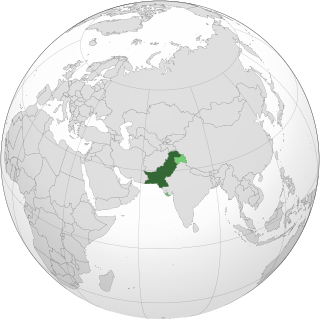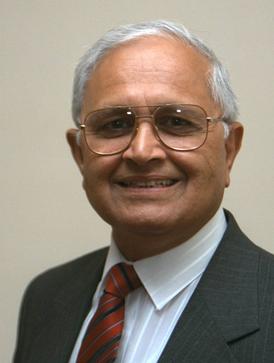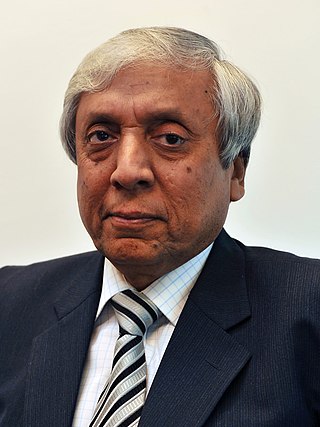
Pakistan is one of nine states that possess nuclear weapons. Pakistan began developing nuclear weapons in January 1972 under Prime Minister Zulfikar Ali Bhutto, who delegated the program to the Chairman of the Pakistan Atomic Energy Commission (PAEC) Munir Ahmad Khan with a commitment to having the device ready by the end of 1976. Since PAEC, which consisted of over twenty laboratories and projects under reactor physicist Munir Ahmad Khan, was falling behind schedule and having considerable difficulty producing fissile material, Abdul Qadeer Khan, a metallurgist working on centrifuge enrichment for Urenco, joined the program at the behest of the Bhutto administration by the end of 1974. As pointed out by Houston Wood, "The most difficult step in building a nuclear weapon is the production of fissile material"; as such, this work in producing fissile material as head of the Kahuta Project was pivotal to Pakistan developing the capability to detonate a nuclear weapon by the end of 1984.

Mianwali city in Mianwali Tehsil, is the capital city of Mianwali District in Punjab, Pakistan. The 81st largest city of Pakistan, it is known for its diverse population of, Punjabi and Pashtun ethnicities.

Pakistan Atomic Energy Commission (PAEC) is a federally funded independent governmental agency, concerned with research and development of nuclear power, promotion of nuclear science, energy conservation and the peaceful usage of nuclear technology.
The Karachi Nuclear Power Plant is a large commercial nuclear power plant located at the Paradise Point in Karachi, Sindh, Pakistan.

The Pakistan Nuclear Regulatory Authorityپاکستان نیوکلیئر ریگولیٹری اتھارٹى; (PNRA), is mandated by the Government of Pakistan to regulate the use of nuclear energy, radioactive sources and ionizing radiation. The mission of PNRA is to protect the public, radiation workers and environment from the harmful effects of ionizing radiation by formulating and implementing effective regulations, building a relationship of trust with licensees, and maintaining transparency in its actions and decisions.
Khushab Nuclear Complex is a plutonium production nuclear reactor and heavy water complex situated 30 km south of the town of Jauharabad in Khushab District, Punjab, Pakistan.
As of 2022, nuclear power is provided by six commercial nuclear power plants in Pakistan. Pakistan is the first Muslim majority country in the world to construct and operate civil nuclear power plants. The Pakistan Atomic Energy Commission (PAEC), the scientific and nuclear governmental agency, is solely responsible for operating these power plants. As of 2018, the electricity generated by commercial nuclear power plants constitutes roughly 7.5% of electricity generated in Pakistan, Pakistan is not a party to the Nuclear Non-Proliferation Treaty but is a member of the International Atomic Energy Agency. Pakistan plans on constructing 32 nuclear power plants by 2050 and envisions 40,000 MW of nuclear power generation.

Tarapur Atomic Power Station (T.A.P.S.) is located in Tarapur, Palghar, India. It was the first commercial nuclear power station built in India.

China is one of the world's largest producers of nuclear power. The country ranks third in the world both in total nuclear power capacity installed and electricity generated, accounting for around one tenth of global nuclear power generated. As of February 2023, China has 55 plants with 52 GW in operation, 23 under construction with 22 GW and more than 40 planned with 47 GW. About 5% of electricity in the country is due to nuclear energy. These plants generated 417 TWh of electricity in 2022 This is versus the September 2022 numbers of 53 nuclear reactors, with a total capacity of 55.6 gigawatt (GW). In 2019, nuclear power had contributed 4.9% of the total Chinese electricity production, with 348.1 TWh.
The Pakistan Nuclear Power Fuel Complex (PNPFC), also known as Chemical Reprocessing Plant (CrP), is a nuclear energy and reprocessing industrial complex for the PWR-type reactors. The NPFC-I is a dual purpose nuclear power plant, with a net capacity of 1000 MWe, located 175 km south of Islamabad. The reactor is designed for converting U3O8 to natural UF6, and enriched UF6 into UO2 powder, then converted depleted UF6 into depleted uranium metal and produced zircon ingot. The PNPFC is ingeniously constructed by the Pakistan Atomic Energy Commission (PAEC) under the IAEA terms, as IAEA is funding this megaproject.

Munir Ahmad Khan, NI, HI, FPAS, was a Pakistani nuclear reactor physicist who is credited, among others, with being the "father of the atomic bomb program" of Pakistan for their leading role in developing their nation's nuclear weapons during the successive years after the war with India in 1971.

Parvez Butt, is a Pakistani mechanical engineer and public official who served as the chairman of the Pakistan Atomic Energy Commission from 2001 till 2006.

Ishrat Hussain Usmani NI, best known as I. H. Usmani, was a Pakistani atomic physicist, and later a public official who chaired the Pakistan Atomic Energy Commission (PAEC) from 1960 to 1971 as well as overseeing the establishment of the Space Research Commission.

Ansar Pervaiz, also spelled as, HI, is a Pakistani scientist and a nuclear engineer who was the former chairman of the Pakistan Atomic Energy Commission (PAEC), and former chairman of the Board of Governors of International Atomic Energy Agency (IAEA). Pervaiz is widely given credit for establishing the nuclear engineering, nuclear physics and nuclear technology institutes within Pakistan.

The Pakistan Atomic Research Reactor or (PARR) are two nuclear research reactors and two other experimental neutron sources located in the PINSTECH Laboratory, Nilore, Islamabad, Pakistan.
Changjiang Nuclear Power Plant is a nuclear power plant in Tangxing Village of Haiwei Township, Changjiang Li Autonomous County in the province of Hainan. It is the first power plant of its kind in the province.
The Darkhovin Nuclear Power Plant is a planned nuclear power plant located in Khuzestan province, Iran about 70 kilometers south of Ahvaz at the Karun river. Construction of one reactor has started. Some other projects on this site were cancelled.
The CNP-600 is a pressurized water nuclear reactor developed by the China National Nuclear Corporation (CNNC).
The CNP-300 is a pressurized water nuclear reactor developed by the China National Nuclear Corporation (CNNC).
The CNP Generation II nuclear reactors were a series of nuclear reactors developed by China National Nuclear Corporation (CNNC), and are predecessors of the more current Hualong One design.












